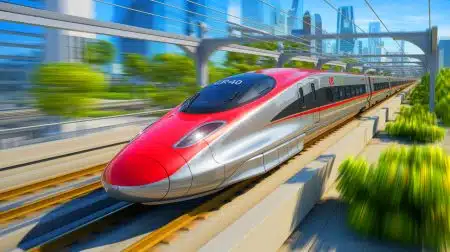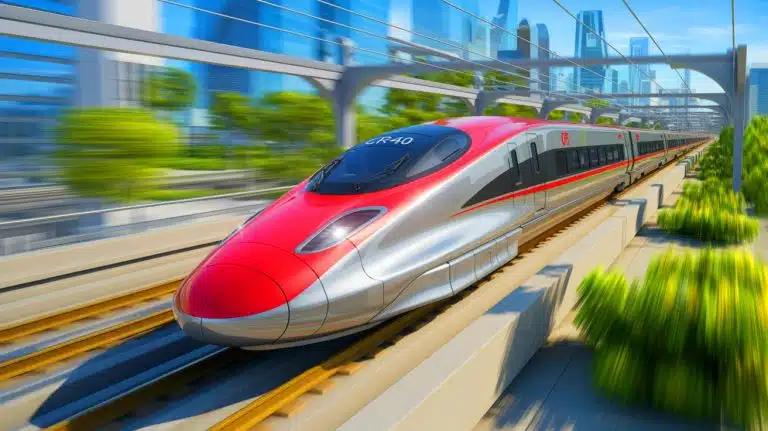| IN A NUTSHELL |
|
As the world continues to modernize transportation, China is making significant strides in high-speed rail technology. The country is on the brink of launching the CR450, a bullet train capable of reaching speeds up to 250 mph. Engineered by the China Academy of Railway Sciences and manufactured by the China Railway Rolling Stock Corporation (CRRC), this train exemplifies the cutting-edge advancements in rail systems. Meanwhile, the United States faces setbacks with its high-speed rail initiatives, particularly in California. This contrast underscores the divergent paths the two nations are taking in the realm of modern transportation.
Innovative Design and Aerodynamics
The CR450 is not just about speed; it represents a leap in aerodynamic design. The engineering team focused on reducing air resistance, a significant challenge that becomes critical at speeds nearing 250 mph. Air resistance, which accounts for 95 percent of the drag on high-speed trains, presented a barrier that needed innovative solutions.
Inspired by nature, engineers studied the streamlined shapes of fast-flying birds. This research led to a redesigned train head that reduces drag by approximately 2.6 percent. Additionally, the train’s undercarriage received a makeover. Often overlooked, this area was optimized with a special cladding system that covers exposed parts. This development resulted in a 22 percent drop in aerodynamic resistance.
The CR450’s ability to maintain the same energy consumption as its predecessor, the CR400 Fuxing trains, despite the increased speed, highlights its energy efficiency. This achievement is a testament to the meticulous engineering and strategic design choices made during its development.
Advanced Braking Systems
Traveling at speeds of 250 mph necessitates an equally advanced braking system. One of the primary challenges was managing the intense heat generated during deceleration. The engineering team developed a novel brake material capable of withstanding high temperatures, maintaining integrity under stress, and resisting deformation.
While the specifics of the materials used remain undisclosed, the development process involved extensive testing and validation. The CR450’s braking system allows it to come to a complete stop from 250 mph in just over 4 miles. This capability is crucial for safety and efficiency, particularly in densely populated areas.
The CR450 was recently showcased at a railway industry conference in Beijing, drawing significant interest from attendees. As China continues to expand its high-speed rail network, the CR450 is set to become a vital component in the nation’s transportation infrastructure.
Why trucks remain essential for small businesses in the modern era
Challenges in the United States
In stark contrast to China’s advancements, the United States faces challenges in its high-speed rail ambitions. The California High-Speed Rail project, aimed at connecting major cities like Los Angeles and San Francisco, has encountered numerous obstacles. These include rising costs, political opposition, and logistical delays.
Recently, the U.S. government under former President Donald Trump canceled $4 billion in federal funding for the project. The announcement, made via Trump’s social media platform, criticized the project as a costly failure, citing cost overruns and lack of tangible progress.
This funding cut raises serious questions about the future of high-speed rail in the U.S., especially as China prepares to launch a more advanced and efficient train. The differing trajectories of the two nations highlight contrasting priorities and challenges in high-speed rail development.
The Global Implications of High-Speed Rail
China’s progress in high-speed rail has significant implications beyond its borders. The country’s rail network already covers 48,000 miles, connecting major urban centers and facilitating economic growth. The introduction of the CR450 is set to further cement China’s position as a leader in high-speed rail technology.
As other countries observe China’s advancements, there may be increased interest in adopting similar technologies. High-speed rail offers a sustainable and efficient alternative to air and road travel, reducing carbon emissions and traffic congestion.
The global emphasis on sustainable transportation solutions makes high-speed rail an attractive option for many nations. However, the challenges faced by the United States serve as a cautionary tale, highlighting the importance of strong political support and strategic planning in infrastructure projects.
The developments in high-speed rail technology reflect broader trends in global transportation. While China forges ahead with innovations like the CR450, the United States grapples with political and logistical hurdles. As nations around the world consider their own transportation futures, the question remains: How will they balance innovation, sustainability, and practicality in their infrastructure endeavors?
Did you like it? 4.3/5 (22)







Wow, China’s really speeding ahead with this train! 🚄 Why can’t the U.S. keep up?
Wow, 250 mph! 🚄 When can we expect to see something like this in the US?